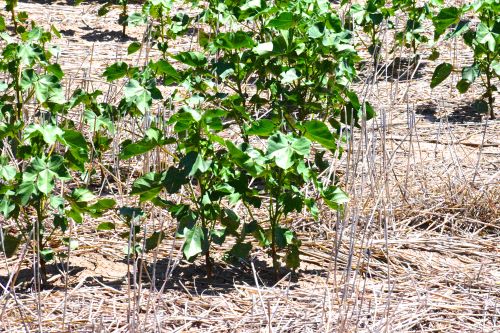Drought, Weak Prices, High Input Costs Pressure West Texas Dryland Acres
March 15. That date, pooled with the price of cotton and inputs — plus available soil moisture — will likely determine the number of the 2023 dryland cotton acres planted in West Texas and the Panhandle.
Why March 15? That’s the date the USDA requires producers to pull cattle off wheat pasture if they plan to carry wheat to harvest. And with late-year wheat prices much more attractive than cotton prices, Southern Plains growers may opt to carry wheat to harvest rather than plant cotton in wheat residue.
Cotton traditionally works well with a wheat cover crop. But will high wheat prices cause growers to carry wheat to harvest or terminate it in March? (Photo: Larry Stalcup)
The region is coming off a beleaguered drought year that rivals the dreadful one of 2011. It may be worse. At least ’11 had “good planting moisture,” noted says Kody Bessent, CEO of Plains Cotton Growers, Inc., during a cotton forum held during the Amarillo Farm and Ranch Show in December.
Plains Cotton Growers represents growers in 42 West Texas/Panhandle counties that typically produce close to 40% of the nation’s cotton crop. But rain was next to nothing over much of the region in early ’22. There was little moisture profile, and it remained dry through summer. Nearly all dryland acres were abandoned. Bessent says Texas production may not be much more than 3 million bales, compared to more than 7 million in 2021.
As many lick their wounds, planning for ’23 is underway. Wheat or rye is usually planted as a cover crop in the region. Their growth is variable as the year ends. Some fields are lush from sound rain amounts and are already being grazed. Other fields see lingering hints of drought.
“Early planted wheat looks surprisingly good across much of the region,” says Dr. Jourdan Bell, Texas A&M AgriLife Extension Agronomist in Amarillo. “But if we do not receive more winter and spring precipitation, these fields risk running out of moisture because of the lack of subsoil moisture.”
In the Nov. 1 USDA soil moisture report, the soil profile readings were very short or short for nearly all of Texas. In Texas District 11, which is much of the Panhandle area, subsoil moisture was 37% very short, 45% short, and only 17% adequate. In District 12, which includes much of the South Plains, subsoil moisture was 28% very short, 69% short, and only 3% adequate. District 21, which is part of the Panhandle and Rolling Plains, was wetter. Still, the profile was 35% very short, 33% short, and 42% adequate.
Even though soil profile readings remain short, fall rain has brightened the spirit of many.
“There has been good moisture (for many) so far, especially compared to the same period last year,” says Dr. Murilo Maeda, Texas A&M AgriLife Extension cotton specialist in Lubbock. “Plenty of cover crops were established due to recent moisture, which is great going into next year.
“I would not say, however, that this is enough to give growers a lot of confidence. It is a start and hopefully, weather will continue to cooperate as we head into next year’s planting season.”
Parts of the Southern Plains see better-growing conditions for rotating dryland cotton with wheat or sorghum. Others depend mainly on cotton. Bell says it gets down to whether early 2023 sees enough precipitation. “As stated, if the current drought persists, I believe we will see a reduction in dryland acres,” she says. “But if the drought breaks, I believe that producers will reconsider dryland cotton acres.”
“It all depends on grain and cotton prices,” Maeda says. “However, I do not anticipate any big swings in acreage.”
Pencil It Out
Market volatility reigns. From late August to early November, December ’22 cotton futures dropped from $1.20 per lb. to a low of barely 70 cents before climbing back into the 80s. There were plenty of times to hedge in a good price. But low crop expectations prevented most from gambling on guaranteeing production.
December ’23 futures were in the 70s and low 80s from mid-September through early December. At the same time, December ’23 corn futures were over more than $6 per bushel. And July ’23 winter wheat futures were between $8 and $9 per bushel. With those prices, Southern Plains irrigated growers may be tempted to go with corn or wheat over cotton. Dryland wheat would likely show a better return than dryland cotton.
Also, fertilizer, herbicide, and other input costs are not coming down and will weigh heavily in what is planted. Bell says growers should also consider how crop rotations impact the next crop.
As an example, she says producers “are rapidly accepting offers to buy corn and sorghum stalks. While this is additional income, I am concerned about fields starting to blow as we move into winter and spring ’23 as well as the impact moving into the next cropping season, especially for cotton.
“Our research demonstrates the benefit of corn and sorghum residue on the following cotton crop,” she says. “The residue protects the seedling from wind erosion, reduces evaporation from the soil, and releases nutrients back into the soil as it decomposes.
“In time, we will see greater nutrient deficiencies and ultimately magnify fertilizer input costs on these fields in addition to the immediate risk for wind injury and reduced crop water efficiencies.”
Dwindling Irrigation Water
The drought also hurt irrigated growers. Wells were stressed and many went dry in ’22.
“Trying to spread out a limited amount of water in a full circle will often have a negligible benefit to the crop as a whole,” Maeda says. “Concentrating those resources in a smaller portion of the field may be better from an economic standpoint.
“However, what works for someone doesn’t always mean it will work for you. Trying new strategies in a small area of your farm is usually the best way to get a good feel for how something will work for your specific operation.”
“I believe many producers will carefully consider their corn acres in ’23,” Bell adds. “If the ’23 season forecast remains poor, we may see more pivots split with cotton or a greater percent of pivots on shared water being planted in cotton.”
Start 2023 Clean
The one benefit of the drought was that it kept weeds under control. “But that doesn’t mean a good weed control program isn’t needed for the coming year,” Maeda says.
“Growers should continue to rotate active herbicide ingredients and overlay residuals into the weed management program. It’s also important to try and get weeds when they are still small. That helps take a little pressure off the current herbicide technologies.”
Moisture, crop prices, input costs, and the potential government reference prices – are all critical in measuring what and when to plant. If there’s sufficient moisture, some may carry wheat to harvest and forego cotton. And some may push it to the limit.
It may come down to how it all looks on March 15.









